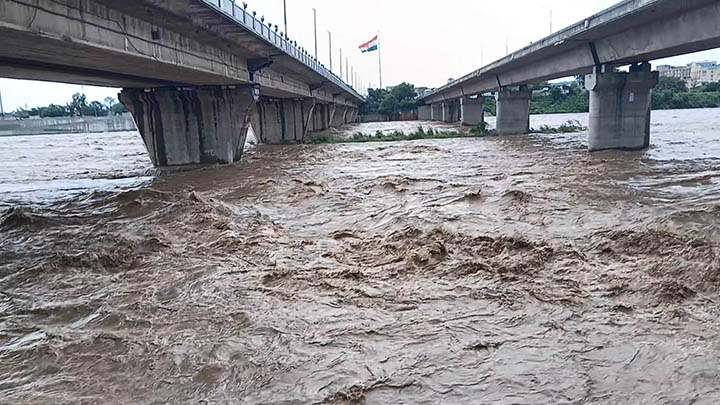
Jammu is facing one of the worst natural rain triggered disasters in recent years. In just 24 hours, the city received 20 cms of rainfall, which is the second-highest August rainfall in the last 100 years. Heavy rains have caused floods, landslides, and serious damage to roads and bridges, bringing life to a complete halt.
Many low-lying areas, including Janipur, Talab Tilloo, Jewel Chowk, Sanjay Nagar, Roop Nagar, and New Plot, are completely waterlogged. Residents say water entered their homes within hours and they had no time to save their belongings.
A major tragedy unfolded when the Logate Morh bridge on the Jammu-Pathankot highway collapsed due to the strong flow of Sahar Khad. This has put hardship on the commuters. Now, there is one way traffic towards the Kathua Pathankot and a diversion of traffic on a longer route.
Lives Lost and Rescue Operations going on in massive scale
So far, four people have lost their lives in different rain-related incidents in Jammu. In nearby districts like Kathua and Kishtwar, cloudbursts and flash floods have claimed over 70 lives. Several people are still missing, and rescue teams are working day and night.
Authorities have deployed SDRF, NDRF, police, and Army teams for evacuation and relief work. At some places, especially near IIIM hostel, boats had to be used to rescue trapped students.
Schools in Rajouri, Reasi, and Poonch have been closed for safety of students, and the IMD has issued a high alert warning of more heavy rain in the coming days.
Why Jammu is Suffering:
Experts say there are four main reasons why Jammu is struggling so much:
- Unusually Heavy Rainfall – The amount of rain received in one day is too much for the city to handle.
- Overflowing Drains and Nallahs – Most drains are either blocked or too old to handle this volume of water.
- Weak Infrastructure – Many bridges and roads are not designed to bear such extreme weather.
- Climate Change – Sudden cloudbursts and unpredictable monsoon patterns are becoming more common.
People’s Anger and Fear:
People are angry and scared. Local residents blame poor planning and weak infrastructure for this crisis. People face the same situation every year, but nothing changes.
People were sleeping when water started entering their house. By the time they woke up, everything was floating. They had to leave their homes in the middle of the night.
What Needs to Be Done:
Officials say they are working on emergency measures, but experts warn that Jammu needs long-term solutions:
- Immediate alerts in high-risk areas
- Better drainage systems with regular cleaning
- Stronger bridges and roads designed to handle heavy rain
- Strict control on construction in flood-prone zones
- Early warning systems for cloudbursts and landslides
While railway bridges stand strong against the raging waters, a few highway bridges have collapsed — a clear reminder that better engineering and planning save lives, while negligence costs us dearly.
Jammu is under siege not by people, but by nature. While rescue teams continue their work, the bigger question remains: will we learn from this disaster, or will the city face the same situation again next year?
For now, Jammu struggles to breathe under water, waiting for relief and hoping for safety.




